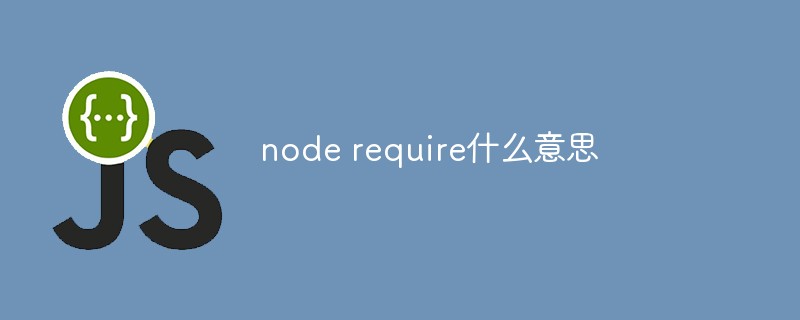node中的require是一個函數,該函數接受一個參數,形參名為id,類型是String;require函數可以導入模塊、JSON文件、本地文件;其中模塊可以通過一個相對路徑從“node_modules”、“本地模塊”或“JSON文件”中導出,該路徑將針對“__dirname”變量或者當前工作目錄。

node.js極速入門課程:進入學習
本教程操作環境:windows7系統、nodejs18.4.0版、Dell G3電腦。
node require什么意思?
Nodejs中的require函數的具體使用方法
說明
本文參考Node官網文檔版本為v11.12.0。
本文主要分析了Nodejs中require導入JSON和js文件時得到的結果,同時簡單涉及到了Nodejs中模塊導出module.exports和exports的用法。
引言
在閱讀webpack源碼的過程當中,見到如下一行代碼:
const version = require("../package.json").version
故引申出對Nodejs中require的學習。
require介紹
在Node.js的文檔中,require的相關文檔是在Modules目錄下,屬于Nodejs模塊化系統的一部分。
require是一個函數。通過typeof或者Object.prototype.toString.call()可以驗證這個結論:
console.log(require) // 輸出:Function console.log(Object.prototype.toString.call(require) // 輸出:[object Function]
通過直接打印require,可以發現在require函數下還掛載著若干個靜態屬性,這些靜態屬性也可以在Nodejs的官方文檔中直接找到相關的說明:
{ [Function: require] resolve: { [Function: resolve] paths: [Function: paths] }, main: Module { id: '.', exports: {}, parent: null, filename: '/Users/bjhl/Documents/webpackSource/index.js', loaded: false, children: [], paths: [ '/Users/bjhl/Documents/webpackSource/node_modules', '/Users/bjhl/Documents/node_modules', '/Users/bjhl/node_modules', '/Users/node_modules', '/node_modules' ] }, extensions: [Object: null prototype] { '.js': [Function], '.json': [Function], '.node': [Function] }, cache: [Object: null prototype] { '/Users/bjhl/Documents/webpackSource/index.js': Module { id: '.', exports: {}, parent: null, filename: '/Users/bjhl/Documents/webpackSource/index.js', loaded: false, children: [], paths: [Array] } } }
require函數靜態屬性
這里之后再詳細補充。
require使用
在官網文檔中可以看到如下關于require的說明:
require(id)# Added in: v0.1.13 id module name or path Returns: exported module content Used to import modules, JSON, and local files. Modules can be imported from node_modules. Local modules and JSON files can be imported using a relative path (e.g. ./, ./foo, ./bar/baz, ../foo) that will be resolved against the directory named by __dirname (if defined) or the current working directory.
同時還給出了三種require的使用方法:
// Importing a local module: const myLocalModule = require('./path/myLocalModule'); // Importing a JSON file: const jsonData = require('./path/filename.json'); // Importing a module from node_modules or Node.js built-in module: const crypto = require('crypto');
從以上文檔中可以得出以下信息:
-
require接受一個參數,形參名為id,類型是String。
-
require函數return的是模塊到處的內容,類型是任意。
-
require函數可以導入模塊、JSON文件、本地文件。模塊可以通過一個相對路徑從node_modules、本地模塊、JSON文件中導出,該路徑將針對__dirname變量(如果已定義)或者當前工作目錄。
require實踐
在這里將分類討論require的實踐結論。
require導入JSON
JSON 是一種語法,用來序列化對象、數組、數值、字符串、布爾值和 null 。
在文章的開頭就提到了通過require("./package.json")文件來讀取package.json文件中的version屬性。這里將嘗試導入info.json文件并查看相關信息。
文件結構目錄如下:
. ├── index.js └── info.json
將info.json文件的內容修改為:
{ "name": "myInfo", "hasFriend": true, "salary": null, "version": "v1.0.0", "author": { "nickname": "Hello Kitty", "age": 20, "friends": [ { "nickname": "snowy", "age": 999 } ] } }
在info.json當中,包含了字符串、布爾值、null、數字、對象和數組。
將index.js的內容修改如下并在當前terminal運行命令 node index.js ,得到如下結果:
const info = require("./info.json") console.log(Object.prototype.toString.call(info)) // [object Object] console.log(info.version) // v1.0.0 console.log(info.hasFriend) // true console.log(info.salary) // null console.log(info.author.nickname) // Hello Kitty console.log(info.author.friends) // [ { nickname: 'snowy', age: 999 } ]
可以看到,require導入一個JSON文件的時候,返回了一個對象,Nodejs可以直接訪問這個對象里的所有屬性,包括String、Boolean、Number、Null、Object、Array。個人猜測這里可能用到了類似于JSON.parse()的方法。
通過這個結論也得出了一種思路,即通過require方法傳入JSON文件來讀取某些值,如在文章開頭中,webpack通過讀取package.json文件獲取到了version值。
require導入本地js文件
文件結構目錄如下:
. ├── index.js ├── module_a.js └── module_b.js
index.js文件中,分別按順序導入了module_a和module_b并賦值,然后將這兩個變量打印,內容如下:
console.log("*** index.js開始執行 ***") const module_a = require("./module_a") const module_b = require("./module_b") console.log(module_a, "*** 打印module_a ***") console.log(module_b, "*** 打印module_b ***") console.log("*** index.js結束執行 ***")
module_a文件中,未指定module.exports或者exports,但是添加了一個異步執行語句setTimeout,內容如下:
console.log("** module_a開始執行 **") let name = "I'm module_a" setTimeout(() => { console.log(name, "** setTimeout打印a的名字 **") }, 0) console.log("** module_a結束執行 **")
module_b文件中,指定了module.exports(也可以換成exports.name,但是不能直接使用exports等于某個對象,因為exports和module.exports其實是指向了一個地址,引用了相同的對象,如果使用exports等于其他的引用類型,則不再指向module.exports,無法改變module.exports里的內容),內容如下:
console.log("** module_b開始執行 **") let name = "I'm module_b" console.log(name, "** 打印b的名字 **") module.exports = { name } console.log("** module_b結束執行 **")
在當前目錄terminal下運行 node index.js 運行得到如下輸出:
*** index.js開始執行 ***
** module_a開始執行 **
** module_a結束執行 **
** module_b開始執行 **
I am module_b ** 打印b的名字 **
** module_b結束執行 **
{} '*** 打印module_a ***'
{ name: 'I am module_b' } '*** 打印module_b ***'
*** index.js結束執行 ***
I am module_a ** setTimeout打印a的名字 **
通過以上執行結果可以得出結論:
-
require某個js文件時,如果未通過exports或者module.exports指定導出內容,則require返回的結果是一個空對象;反之可以通過module.export或者給exports屬性賦值來導出指定內容。
-
require某個js文件時,該文件會立即sync執行。
require導入模塊
我們先選擇一個npm包——cors。 進入文件夾,運行一下命令:
npm init -y // 初始化 echo -e "let cors = require("cors")nconsole.log(cors)" > index.js // 生成index.js文件 npm install cors --save // 安裝cors包
文件結構如下(…處省略了其他的模塊):
. ├── index.js ├── node_modules │ ├── cors │ │ ├── CONTRIBUTING.md │ │ ├── HISTORY.md │ │ ├── LICENSE │ │ ├── README.md │ │ ├── lib │ │ │ └── index.js │ │ └── package.json │ │ ... ├── package-lock.json └── package.json
index.js中的內容如下:
let cors = require("cors") console.log(cors)
運行 node index.js ,得出以下結果:
[Function: middlewareWrapper]
找到node_modules下的cors模塊文件夾,觀察cros模塊中的package.json文件,找到main字段: "main": "./lib/index.js" ,找到main字段指向的文件,發現這是一個IIFE,在IIFE中的代碼中添加,console.log("hello cors"),模擬代碼結構如下:
(function () { 'use strict'; console.log("hello cors"); // 這是手動添加的代碼 ... function middlewareWrapper(o) { ... } module.exports = middlewareWrapper; })()
再次運行 node index.js ,得出以下結果:
hello cors
[Function: middlewareWrapper]
為什么會打印出 hello cors 呢?因為require模塊的時候,引入的是該模塊package.json文件中main字段指向的文件。而這個js文件會自動執行,跟require引用本地js文件是相同的。
packjson文檔
在npm的官方網站中可以找到關于package.json中的main字段定義。
main The main field is a module ID that is the primary entry point to your program. That is, if your package is named foo, and a user installs it, and then does require("foo"), then your main module's exports object will be returned. This should be a module ID relative to the root of your package folder For most modules, it makes the most sense to have a main script and often not much else.
在以上說明中可以得出以下結論:
-
main字段是一個模塊ID,是程序的主入口。
-
當使用require("xxx")的時候,導入的是main字段對應的js文件里的module.exports。
所以require導入模塊的時候,是運行的對應模塊package.json中main字段指定的文件。
推薦學習:《node視頻教程》
 站長資訊網
站長資訊網